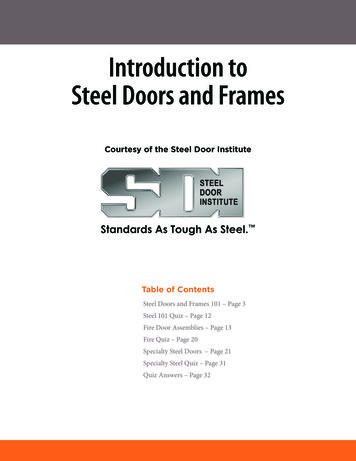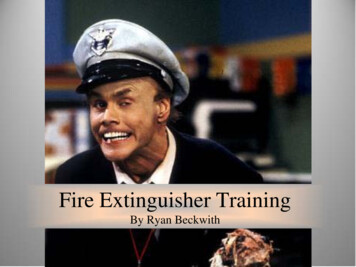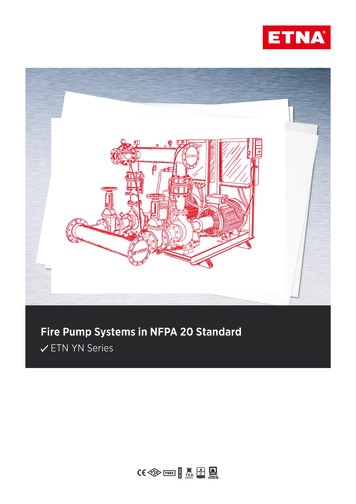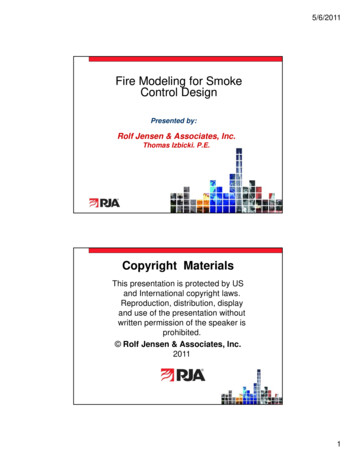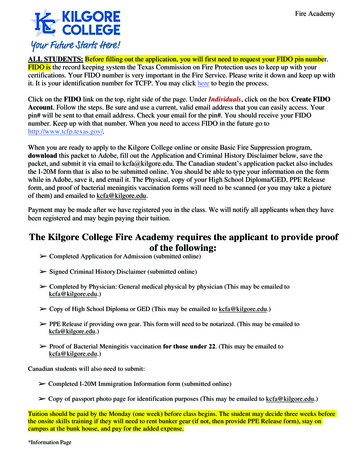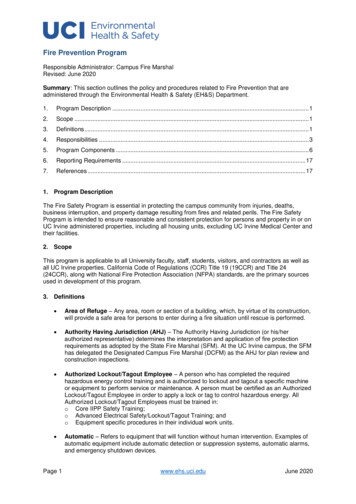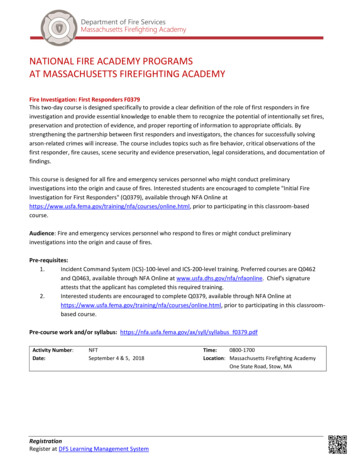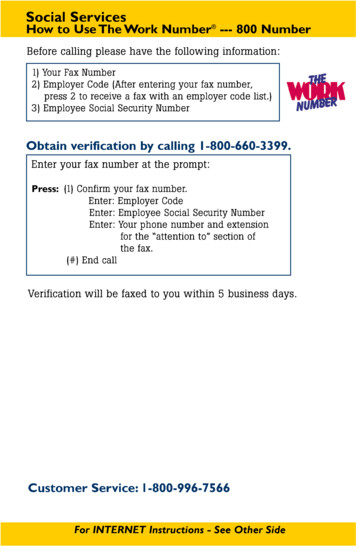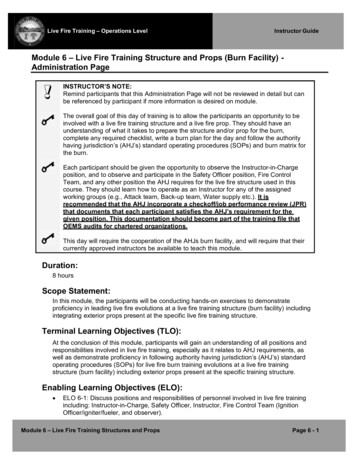
Transcription
Live Fire Training – Operations LevelInstructor GuideModule 6 – Live Fire Training Structure and Props (Burn Facility) Administration PageINSTRUCTOR’S NOTE:Remind participants that this Administration Page will not be reviewed in detail but canbe referenced by participant if more information is desired on module.The overall goal of this day of training is to allow the participants an opportunity to beinvolved with a live fire training structure and a live fire prop. They should have anunderstanding of what it takes to prepare the structure and/or prop for the burn,complete any required checklist, write a burn plan for the day and follow the authorityhaving jurisdiction’s (AHJ’s) standard operating procedures (SOPs) and burn matrix forthe burn.Each participant should be given the opportunity to observe the Instructor-in-Chargeposition, and to observe and participate in the Safety Officer position, Fire ControlTeam, and any other position the AHJ requires for the live fire structure used in thiscourse. They should learn how to operate as an Instructor for any of the assignedworking groups (e.g., Attack team, Back-up team, Water supply etc.). It isrecommended that the AHJ incorporate a checkoff/job performance review (JPR)that documents that each participant satisfies the AHJ’s requirement for thegiven position. This documentation should become part of the training file thatOEMS audits for chartered organizations.This day will require the cooperation of the AHJs burn facility, and will require that theircurrently approved instructors be available to teach this module.Duration:8 hoursScope Statement:In this module, the participants will be conducting hands-on exercises to demonstrateproficiency in leading live fire evolutions at a live fire training structure (burn facility) includingintegrating exterior props present at the specific live fire training structure.Terminal Learning Objectives (TLO):At the conclusion of this module, participants will gain an understanding of all positions andresponsibilities involved in live fire training, especially as it relates to AHJ requirements, aswell as demonstrate proficiency in following authority having jurisdiction’s (AHJ’s) standardoperating procedures (SOPs) for live fire burn training evolutions at a live fire trainingstructure (burn facility) including exterior props present at the specific training structure.Enabling Learning Objectives (ELO): ELO 6-1: Discuss positions and responsibilities of personnel involved in live fire trainingincluding: Instructor-in-Charge, Safety Officer, Instructor, Fire Control Team (IgnitionOfficer/igniter/fueler, and observer).Module 6 – Live Fire Training Structures and PropsPage 6 - 1
Live Fire Training – Operations LevelInstructor Guide ELO 6-2: Discuss AHJ’s standard operating procedures for all positions and props. ELO 6-3: Demonstrate proficiency and understanding of all positions per AHJ’s standardoperating procedures for training site. ELO 6-4: Demonstrate proficiency in inspecting and testing gas-fired live fire trainingstructures prior to and after completing live fire training evolutions, if applicable totraining site. ELO 6-5: Demonstrate proficiency in inspecting and testing non-gas-fired live fire trainingstructures prior to and after completing live fire training evolutions, if applicable to trainingsite. ELO 6-6: Demonstrate proficiency in creating a burn sequence matrix chart for the burnrooms in the live fire training structure that includes maximum fuel loads and maximumnumber of sequential evolutions based on the AHJ’s safe live fire training action plan. ELO 6-7: Demonstrate proficiency in inspecting, maintaining, and integrating exteriorprops in live fire training evolutions.Resources:See resources as outlined in the activities description within the moduleInstructor to Participant Ratio:1:5Reference ListN/APractical Exercise Statement:See activities description in moduleAssessment Strategy: Observation of student participation as well as performance in group activities Instructor facilitated verbal review of module content during debriefingPrerequisites: Refer to the Ohio Emergency Medical Services (OEMS) Firefighter and Fire Safety InspectorTraining Subcommittee list of prerequisites included at the beginning of this manualModule 6 – Live Fire Training Structures and PropsPage 6 - 2
Live Fire Training – Operations LevelInstructor GuideModule 6 – Live Fire Training Structure and Props (Burn Facility)Instructor Notes Icon MapIconDescriptionKnowledge Check: Used when it is time toassess the learners’ understandingExample: Used when there is a descriptiveillustration to show or explainKey Points: Used to convey essential learningconcepts, discussions and introduction ofsupplemental materialHint: Used to cover administrative items orinstructional tips that aid in the flow of theinstructionInteraction: Used for suggested small groupactivity or other interactionVideo: Used to prompt instructor to play avideo, which has been included on the slideModule 6 – Live Fire Training Structures and PropsPage 6 - 3
Live Fire Training – Operations LevelInstructor GuideModule 6 – Live Fire Training Structure and Props (Burn Facility)INSTRUCTOR’S NOTE:Review the module 6 learning objectives on this slides below. It is imperative that theauthority having jurisdiction (AHJ) facilities’ standard operating procedures forconducting live burns are followed for all training exercises.Live Fire Training – Operations LevelModule 6 – Live Fire Training Structureand Props (Burn Facility)Learning Objectives: Discuss positions and responsibilities of personnel involved inlive fire training including: Instructor-in-Charge, Safety Officer,Instructor, Fire Control Team (Ignition Officer, and Observer) Discuss AHJ’s standard operating procedures for all positionsand props Demonstrate proficiency and understanding of all positions perAHJ’s standard operating procedures for training siteSlide 6-1Live Fire Training – Operations LevelModule 6 – Live Fire Training Structureand Props (Burn Facility)Learning Objectives (continued): Demonstrate proficiency in:– Inspecting and testing gas-fired and/or non-gas fired (dependingon training site) live fire training structures prior to and aftercompleting live fire training evolutions– Creating a burn sequence matrix chart for the burn rooms in thelive fire training structure that includes maximum fuel loads andmaximum number of sequential evolutions based on the AHJ’ssafe live fire training action plan– Inspecting, maintaining, and integrating exterior props in live firetraining evolutionsSlide 6-2Module 6 – Live Fire Training Structures and PropsPage 6 - 4
Live Fire Training – Operations LevelInstructor GuideModule 6 – Live Fire Training Structure and Props (Burn Facility)INSTRUCTOR’S NOTE:Since the responsibilities of the Instructor-in-Charge (IiC) were discussed in module 2,ask participants what are some of the responsibilities of the IiC? Review the NFPA1403 responsibilities of the Instructor-in-Charge listed on this slide and those coveredon subsequent slides.Live Fire Training – Operations LevelInstructor-in-Charge Plan and coordinate all training activities Monitor activities to ensure safe practices Inspect training structure integrity prior toeach fireSlide 6-3Module 6 – Live Fire Training Structures and PropsPage 6 - 5
Live Fire Training – Operations LevelInstructor GuideModule 6 – Live Fire Training Structure and Props (Burn Facility)INSTRUCTOR’S NOTE:Continue to review IiC responsibilities listed on slide below.Live Fire Training – Operations LevelInstructor-in-Charge (cont.) Assign instructors:- Attack hose lines- Backup hose lines- Functional assignments- Teaching assignmentsSlide 6-4Module 6 – Live Fire Training Structures and PropsPage 6 - 6
Live Fire Training – Operations LevelInstructor GuideModule 6 – Live Fire Training Structure and Props (Burn Facility)INSTRUCTOR’S NOTE:Continue to review IiC responsibilities listed on slide below.Live Fire Training – Operations LevelInstructor-in-Charge (cont.) Brief instructors on responsibilities:- Accounting for assigned students- Assessing student performance- Clothing and equipment inspection- Monitoring safety- Achieving tactical and training objectivesSlide 6-5Module 6 – Live Fire Training Structures and PropsPage 6 - 7
Live Fire Training – Operations LevelInstructor GuideModule 6 – Live Fire Training Structure and Props (Burn Facility)INSTRUCTOR’S NOTE:This slide concludes the responsibilities of the IiC. The AHJ should cover any specificrequirements for the IiC including any checklists used by AHJ.In addition to the NFPA 1403 example checklist included in module 4 (Responsibilitiesof Personnel), included on the CD of supplemental materials given to each participantis an example checklist of ALL roles and responsibilities from the Ohio Fire Academywhich includes a section specifically for the IiC.Live Fire Training – Operations LevelInstructor-in-Charge (cont.) Ensure adherence to NFPA 1403 by allperson within the training area What are the specific IiC requirementsand checklists of the AHJ?Slide 6-6Module 6 – Live Fire Training Structures and PropsPage 6 - 8
Live Fire Training – Operations LevelInstructor GuideModule 6 – Live Fire Training Structure and Props (Burn Facility)INSTRUCTOR’S NOTE:Review the NFPA 1403 responsibilities of the Safety Officer listed on this slide. Remindparticipants that these responsibilities were discussed in module 2.Live Fire Training – Operations LevelSafety Officer Prevent unsafe acts Eliminate unsafe conditions Intervene and terminate unsafe acts Supervise additional safety personnel, asneeded Coordinate lighting of fires with IiCSlide 6-7Module 6 – Live Fire Training Structures and PropsPage 6 - 9
Live Fire Training – Operations LevelInstructor GuideModule 6 – Live Fire Training Structure and Props (Burn Facility)INSTRUCTOR’S NOTE:This slide concludes the responsibilities of the Safety Officer. The AHJ should coverany specific requirements for the IiC including any checklists used by AHJ.In addition to the NFPA 1403 example checklist included in module 4 (Responsibilitiesof Personnel), included on the CD of supplemental materials given to each participantis an example checklist of ALL roles and responsibilities from the Ohio Fire Academywhich includes a section specifically for the Safety Officer.Live Fire Training – Operations LevelSafety Officer (cont.) Ensure compliance of participants’ personal equipment withapplicable standards- Protective clothing- SCBA- Personal alarm devices, where used Ensure that all participants are accounted for, both beforeand after each evolution What are the specific Safety Officer requirements andchecklists of the AHJ?Slide 6-8Module 6 – Live Fire Training Structures and PropsPage 6 - 10
Live Fire Training – Operations LevelInstructor GuideModule 6 – Live Fire Training Structure and Props (Burn Facility)INSTRUCTOR’S NOTE:Review the NFPA 1403 general requirements of the Fire Control Team as listed on thisslide. Specifics on each member of the Fire Control Team are discussed onsubsequent slides. Remind participants that these responsibilities were discussed inmodule 2. No one should be alone inside the live fire training structure. Alwayshave an observer.Live Fire Training – Operations LevelFire Control Team Minimum of 2 people- Ignition Officer- Observer Shall wear full PPC, including SCBASlide 6-9Module 6 – Live Fire Training Structures and PropsPage 6 - 11
Live Fire Training – Operations LevelInstructor GuideModule 6 – Live Fire Training Structure and Props (Burn Facility)INSTRUCTOR’S NOTE:Review the NFPA 1403 responsibilities of the Ignition Officer listed on this slide.Remind participants that these responsibilities were discussed in module 2.In addition to the NFPA 1403 example checklist included in module 4 (Responsibilitiesof Personnel), included on the CD of supplemental materials given to each participantis an example checklist of ALL roles and responsibilities from the Ohio Fire Academywhich includes a section specifically for the Ignition Officer.Live Fire Training – Operations LevelIgnition Officer Ignite, maintain, and control the materialsbeing burned Ignite the training fire at the direction of theIiC in coordination with SO and afterconfirmation the area is clear of personnelSlide 6-10Module 6 – Live Fire Training Structures and PropsPage 6 - 12
Live Fire Training – Operations LevelInstructor GuideModule 6 – Live Fire Training Structure and Props (Burn Facility)INSTRUCTOR’S NOTE:A general guideline is to build burn boxes to allow airflow, and arrange pallets or doorsto block hose streams. The pictures included on the slide show how the burn boxescould be built to allow airflow.Live Fire Training – Operations LevelSlide 6-11Module 6 – Live Fire Training Structures and PropsPage 6 - 13
Live Fire Training – Operations LevelInstructor GuideModule 6 – Live Fire Training Structure and Props (Burn Facility)INSTRUCTOR’S NOTE:This slide relates to an acquired structure where reinforcing the area at the burn boxwith drywall and/or sheet metal will extend the lifespace of the burn.Live Fire Training – Operations LevelReinforcing the area at the burn box withdrywall and/or sheet metal will extend thelifespan of the burn.Slide 6-12Module 6 – Live Fire Training Structures and PropsPage 6 - 14
Live Fire Training – Operations LevelInstructor GuideModule 6 – Live Fire Training Structure and Props (Burn Facility)INSTRUCTOR’S NOTE:Review the responsibilities of the Observer. Reiterate no one should be in a live firetraining structure unobserved or alone.This slide concludes the responsibilities of the Fire Control Team. The AHJ shouldcover any specific requirements for the Fire Control Team including any checklists usedby AHJ.In addition to the NFPA 1403 example checklist included in module 4 (Responsibilitiesof Personnel), included on the CD of supplemental materials given to each participantis an example checklist of ALL roles and responsibilities from the Ohio Fire Academywhich includes a section specifically for the members of the Fire Control Team.Live Fire Training – Operations LevelFire Control Team –Ignition Officer - Observer Observes the ignition officer Recognizes, reports, and responds toadverse conditions What are the specific Fire Control Teamrequirements and checklists of the AHJ?Slide 6-13Module 6 – Live Fire Training Structures and PropsPage 6 - 15
Live Fire Training – Operations LevelInstructor GuideModule 6 – Live Fire Training Structure and Props (Burn Facility)INSTRUCTOR’S NOTE:Review the NFPA 1403 responsibilities of the Instructor listed on this slide. Remindparticipants that these responsibilities were discussed in module 2.In addition to the NFPA 1403 example checklist included in module 4 (Responsibilitiesof Personnel), included on the CD of supplemental materials given to each participantis an example checklist of ALL roles and responsibilities from the Ohio Fire Academywhich includes a section specifically for the Instructor.Live Fire Training – Operations LevelInstructor Monitor and supervise assigned students(no more than 5 per instructor) Inspect students’ protective clothing andequipment Account for assigned students, both before andafter evolutions What are the specific Instructor requirementsand checklists of the AHJ?Slide 6-14Module 6 – Live Fire Training Structures and PropsPage 6 - 16
Live Fire Training – Operations LevelInstructor GuideModule 6 – Live Fire Training Structure and Props (Burn Facility)INSTRUCTOR’S NOTE:The AHJ Standard Operating Procedures should be reviewed at this time.Included as a resource on the CD of supplemental materials given to each participantare several example documents/checklists for live fire burns at the Ohio Fire Academythat are incorporated into their standard operating procedures. These examples can beused to create or enhance existing AHJ checklists/documents for live fire burns.Live Fire Training – Operations LevelAuthority Having JurisdictionReview ofStandard Operating ProceduresSlide 6-15Module 6 – Live Fire Training Structures and PropsPage 6 - 17
Live Fire Training – Operations LevelInstructor GuideHands-on Group Activities – Day 2 Live Fire Training Structure and PropsIntroduction/Rationale:A series of activities will be conducted at the live fire training structure (burn facility) to allowparticipants to demonstrate proficiency in leading live fire burn evolutions including exteriorprops present at the specific fixed burn facility.The overall goal of this day of training is to allow the participants an opportunity to be involvedwith a live fire training structure and a live fire prop. They should have an understanding ofwhat it takes to prepare the structure and/or prop for the burn, complete any required checklist,write a burn plan for the day and follow the AHJ’s SOPs and burn matrix for the burn.Each participant should be given the opportunity to observe the Instructor-in-Charge position,and to observe and participate in the Safety Officer position, Fire Control Team, and any otherposition the AHJ requires for the live fire structure used in this course. They should learn howto operate as an Instructor for any of the assigned working groups (e.g., Attack team, Back-upteam, Water supply etc.). It is recommended that the AHJ incorporate a checkoff/jobperformance review (JPR) that documents that each participant satisfies the AHJ’srequirement for the given position. This documentation should become part of thetraining file that OEMS audits for chartered organizations.This day will require the cooperation of the AHJs burn facility, and will require that theircurrently approved instructors be available to teach this module.Action to be Completed (under the direction of the AHJ’s instructors):PART 1 – Live Fire Training Structure:1) PRIOR TO DAY 2 of training, the burn plan for the live fire training structure must be inplace, including the use of a burn sequence matrix, if utilized then review withparticipants at the beginning of Day 2 during the pre-briefing in the classroom andrepeated at the burn building2) Perform pre-inspection of the live fire training structure (burn facility)3) Document any damage to the live fire training structure (burn facility)4) Inspect all safety devices, doors, windows, etc. and operate any ventilation equipmentto ensure operability5) Secure and set up the required water supply6) Set up burn boxes or learn to operate gas fired devices7) Rotate the role of Instructor-in-Charge, Safety Officer, Ignition Officer, Ignition OfficerObserver, and Instructor and any other assigned position per AHJ’s SOP8) Perform post burn inspection9) Perform debrief of the activitiesModule 6 – Live Fire Training Structures and PropsPage 6 - 18
Live Fire Training – Operations LevelInstructor GuidePART 2 – Exterior Live Fire Training Props:1) PRIOR TO DAY 2 of training, the burn plan for the live fire training props must be inplace, for the prop involved2) Perform pre-inspection of the burn prop3) Document any damage to the prop4) Inspect all safety devices and operate any valves on the prop5) Secure and set up the required water supply6) Set up burn boxes or learn to operate gas fired devices7) Rotate the role of Instructor-in-Charge, Safety Officer, Ignition Officer, Inside Observer,and Instructor8) Perform post burn inspection of prop9) Perform debrief of the activitiesResources: Live fire training structure facility (burn building) with SOPs for conducting a live fireburn, with exterior propsExterior props with associated SOPs for conducting a live fire burn Live fire training structure facility must provide, at a minimum:o 1 Instructor-in-Chargeo 1 Safety Officero 1 Ignition Officero 1 Ignition Officer Observero Instructors to maintain a 1: 5 instructor to student ratio. The instructors musthave been trained in the use of the AHJ’s live fire training structure and propsaccording to the documented SOP. Apparatus/water supply per AHJ’s SOPFull firefighting Personal Protective Equipment (PPE) for students and instructors Checklists per AHJ’s SOPPermits/notifications per AHJ’s SOP Fuel materials per AHJ’s SOP Ventilation tools per AHJ’s SOPModule 6 – Live Fire Training Structures and PropsPage 6 - 19
Live Fire Training – Operations LevelInstructor GuideModule 6 – Live Fire Training Structure and Props (Burn Facility)INSTRUCTOR’S NOTE:These slides detail the activities that are listed in the summary table to be performedat the live fire training structure (Part 1). Since there may be limited time in theclassroom at the beginning of this day 2 of training, reviewing the summary table maybe the only briefing to go over objectives and actions to be completed; therefore, thefollowing slides may not be shown to the participants.Live Fire Training – Operations LevelActions to Be Completed – Part 11. Develop the burn plan for the day includingthe use of a burn sequence matrix, if utilized2. Perform pre-inspection of the live fire trainingstructure (burn facility)3. Document any damage to the live fire trainingstructure (burn facility)4. Inspect all safety devices, doors, windows,etc. and operate any ventilation equipmentSlide 6-16Live Fire Training – Operations LevelActions to Be Completed – Part 1(cont.)5. Secure and set up the required water supply6. Set up burn boxes or learn to operate gasfired devices7. Rotate the role of Instructor-in-Charge, SafetyOfficer, Ignition Officer, Inside Observer, andInstructor8. Perform post burn inspection9. Perform debrief of the activitiesSlide 6-17Module 6 – Live Fire Training Structures and PropsPage 6 - 20
Live Fire Training – Operations LevelInstructor GuideModule 6 – Live Fire Training Structure and Props (Burn Facility)INSTRUCTOR’S NOTE:These slides as well as the content below the slides detail the activities that will beperformed regarding exterior props (Part 2).Live Fire Training – Operations LevelActions to Be Completed – Part 21. Develop the burn plan for the prop involved2. Perform pre-inspection of the burn prop3. Document any damage to the prop4. Inspect all safety devices and operate anyvalves on the prop5. Secure and set up the required water supplySlide 6-18Live Fire Training – Operations LevelActions to Be Completed – Part 2(cont.)6. Set up burn boxes or learn to operate gasfired devices7. Rotate the role of Instructor-in-Charge, SafetyOfficer, Ignition Officer, Inside Observer, andInstructor8. Perform post burn inspection of prop9. Perform debrief of the activitiesSlide 6-19Module 6 – Live Fire Training Structures and PropsPage 6 - 21
Live Fire Training – Operations LevelInstructor GuideModule 6 – Live Fire Training Structure and Props (Burn Facility)INSTRUCTOR’S NOTE:Once back in the classroom after completing the Day 2 objectives at the burn facility,review the Day 2 objectives and actions completed with group. Discuss each actioncompleted allowing participants to discuss any questions, issues, or concernsexperienced during the day.Live Fire Training – Operations LevelDay 2 – Live Fire TrainingStructure and Props (Burn Facility) Class debriefing to ensureobjectives were metSlide 6-20Module 6 – Live Fire Training Structures and PropsPage 6 - 22
Module 6 – Live Fire Training Structures and Props Page 6 - 1 Module 6 – Live Fire Training Structure and Props (Burn Facility) - . - Personal alarm devices, where used Ensure that all participants are accounted for, both before . Ignite the training fire at t
